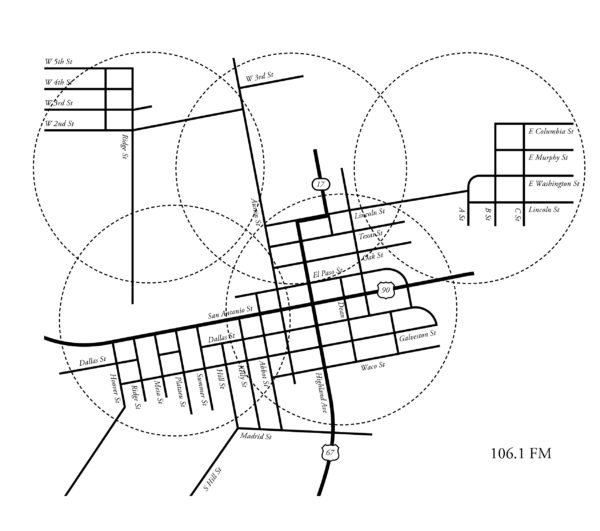“Agreements (5—10)” consists of two objects (cast steel tuning forks) and six radio transmissions. Two of the radio transmissions originated with antennas in the courtyard of Ballroom Marfa, the other four were distributed at various locations around Marfa, TX, forming a ring around the town so that you were never more than 1000 feet or so from a transmitter. The transmissions, overlapping geographically and all broadcasting on the same frequency (106.1 fm), compete with one another to reach the listener who chooses to tune in. This competing interference manifests as pockets of clarity, separated by boundaries of noise and silence. Listening while moving, one can hear these borders as they are crossed, and the shift between territories can be heard as dominance rotating from one signal to another.
The tuning forks, one double-sided and the other four-sided, resonate with two and four narrowly-separated pitches, respectively. Each of these reference pitches corresponds directly to one of the six radio transmissions introduced into the otherwise quiet radio spectrum, serving as the basis for the musical universe contained in that signal. All sounds heard in a transmission conform to the tuning note, and its attendant harmonics, that belongs to that transmitter.
Cast as single objects that hold multiple reference pitches, the forks present the limits of sensing the whole of a group. Listening to each individual part in turn, you hold the sound of one ringing note in your memory in order to compare it to another sound. Similarly, your sense of each radio signal is interrupted as your position changes, and the relative power of all signals shift. This is not just a problem of simultaneity, or of a fixed point of view; this is a model of difference—a multiplicity of centers—that is based on inter-penetration, dominance and exclusion, rather than the wave-like interference of phases.
Holding one of the tuning forks in your hand, striking it or tapping it to let it ring, it is clear that each vibrating side produces a complex sympathetic resonance in each of the other sides. Holding any of the sides to mute vibrations, it is possible to alternate between a striated, harmonic sound and a smooth, pure tone. Repetition, with difference. Each transmission carries its own information. What you hear tells you where you are—variations on a theme: wild variations that conform to a system. This is, unfortunately, not the system of infinite combinations imagined when considering sound as a social material, interconnecting listeners universally and without friction, layering and blending to synthesize new forms from multiple masters. This is, luckily, the coequal and simultaneous possibility of multiple, separated centers that can interact but don’t. You can move from one place to another, or you can stay still, friction is the constant force.
